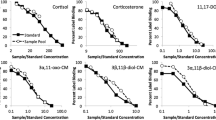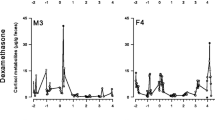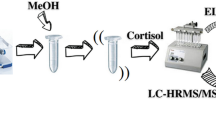Abstract
In this study, we evaluated a non-invasive method for measuring glucocorticoid metabolites (GCM) in the Mountain hare (Lepus timidus). An adrenocorticotrophic hormone challenge test was performed in order to select an appropriate enzyme immunoassay (EIA) to measure faecal GCM. Finally, an 11-oxoaetiocholanolone EIA and a 5α-pregnane-3β,11β,21-triol-20-one EIA were chosen. Both assays showed small fluctuations in baseline values and a clear response after stimulation of the adrenocortical activity. To test the stability of faecal metabolites under field conditions, the effects of different storage conditions and periods on GCM concentrations were examined. The assays revealed low fluctuations in metabolite concentrations within the storage period of 12, 24, 48 and 72 h, both at ambient temperatures of 10°C and 25°C, respectively. A washing-out effect of water was found for both assays, which must be taken into account in field studies. The results indicate that this non-invasive method can be used to evaluate glucocorticoid levels of free-ranging Mountain hares.


Similar content being viewed by others
References
Arlettaz R, Patthey P, Baltic M, Leu T, Schraub M, Palme R, Jenni-Eiermann S (2007) Spreading free-riding snow sports represent a novel serious threat for wildlife. Proc Biol Sci 274:1219–1224
Baltic M, Jenni-Eiermann S, Arlettaz R, Palme R (2005) A noninvasive technique to evaluate human generated stress in the Black grouse. Ann N Y Acad Sci 1046:81–95
Bubenik GA, Brown RD (1989) Seasonal levels of cortisol, triiodothyronine and thyroxine in male axis deer. Comp Biochem Physiol A 92:499–503
Dalmau A, Ferret A, Chacon G, Manteca X (2007) Seasonal changes in fecal cortisol metabolites in pyrenean chamois. J Wildl Manage 71:190–194
Dehnhard M, Clauss M, Lechner-Doll M, Meyer HHD, Palme R (2001) Noninvasive monitoring of adrenocortical activity in Roe deer (Capreolus capreolus) by measurement of faecal cortisol metabolites. Gen Comp Endocrinol 123:111–120
Gamboni AS (1997). Comportement spatio-temporel d`une population de lievre variable (Lepus timidus varronis) au sud des alpes. Travail de Diplôme Université de Neuchâtel, pp 15-36
Hackländer K, Möstl E, Arnold W (2003) Reproductive suppression in female alpine marmots, Marmota marmota. Anim Behav 65:1133–1140
Huber S, Palme R, Arnold W (2003) Effects of season, sex, and sample collection on concentrations of fecal cortisol metabolites in red deer (Cervus elaphus). Gen Comp Endocrinol 130:48–54
Ingold P (2005) Freizeitaktivitäten im Lebensraum der Alpentiere. Konfliktbereiche zwischen Mensch und Tier. Mit einem Ratgeber für die Praxis. Verlag Haupt Bern, pp 516-550
Lexen E, El-Bahr SM, Sommerfeld-Stur I, Palme R, Möstl E (2008) Monitoring the adrenocortical response to disturbances in sheep by measuring glucocorticoid metabolites in the faeces. Wien Tierärztl Mschr-Vet Med Austria 95:64–71
Lund-Larsen TR, Kofstad J, Aakvaag A (1978) Seasonal changes in serum levels of aldosterone, cortisol and inorganic ions in the reindeer (Rangifer tarandus). Comp Biochem Physiol A 60:383–386
Meile P. (1984) Alpen-Schneehase (Lepus timidus varronis). Biologie einheimischer Wildarten. Beilage zu Wildtiere 4, Berchtesgaden, pp 22–22.9
Möstl E, Meßmann S, Bagu E, Robia C, Palme R (1999) Measurement of glucocorticoid metabolite concentrations in faeces of domestic livestock. J Vet Med A 46:621–631
Möstl E, Maggs JL, Schrötter G, Besenfelder U, Palme R (2002) Measurement of cortisol metabolites in faeces of ruminants. Vet Res Comm 26:127–139
Monfort SL, Brown JL, Wildt DE (1993) Episodic and seasonal rhythms of cortisol secretion in male eld's deer (Cervus eldi thamin). J Endocrinol 138:41–49
Palme R, Fischer P, Schildorfer H, Ismail MN (1996) Excretion of infused 14C-steroid hormones via faeces and urine in domestic livestock. Anim Reprod Sci 43:43–63
Palme R, Möstl E (1997) Measurement of cortisol metabolites in faeces of sheep as a parameter of cortisol concenctration in blood. Z Saugetierkd – Int J Mammal Biol 62:192–197 Suppl. 2
Palme R, Rettenbacher S, Touma C, El-Bahr SM, Möstl E (2005) Stress hormones in mammals and birds: comparative aspects regarding metabolism, excretion, and noninvasive measurement in faecal samples. Trends in Comparative Endocrinology and Neurobiology. Ann NY Acad Sci 1040:162–171
Palme R (2005) Measuring faecal steroids: guidelines for practical application. Ann NY Acad Sci 1046:75–80
Rettenbacher S, Möstl E, Hackl R, Ghareeb K, Palme R (2004) Measurement of corticosterone metabolites in chicken droppings. Br Poult Sci 45:704–711
Reyes E, Bubenik GA, Lobos A, Schams D, Bartos L (1997) Seasonal levels of cortisol, igf-1 and triiodothyronine in adult male pudu (Pudu pudu). Fol Zool 46:109–116
Sheriff MJ, Bosson CO, Krebs CJ, Boonstra R (2009) A non-invasive technique for analyzing faecal cortisol metabolites in snowshoe hares (Lepus americanus). J Comp Physiol B 179:305–313
Taylor AR, Knight RL (2003) Wildlife responses to recreation and associated visitors perceptions. Ecol Appl 13:951–963
Teskey-Gerstl A, Bamberg E, Steineck T, Palme R (2000) Excretion of corticosteroids in urine and faeces of hares (Lepus europaeus). J Comp Physiol B 170:163–168
Thiel D, Jenni-Eiermann S, Palme R (2005) Measuring corticosterone metabolites in droppings of Capercaillies (Tetrao urogallus). Ann NY Acad Sci 1046:96–108
Thiel D, Jenni-Eiermann S, Braunisch V, Palme R, Jenni L (2008) Ski tourism affects habitat use and evokes a physiological stress response in capercaillie Tetrao urogallus: a new methodological approach. J Appl Ecol 45:845–853
Touma C, Sachser N, Möstl E, Palme R (2003) Effects of sex and time of day on metabolism and excretion of corticosterone in urine and faeces in mice. Gen Comp Endocrinol 130:267–278
Touma C, Palme R, Sachser N (2004) Analyzing corticosterone metabolites in fecal samples of mice: a non-invasive technique to monitor stress hormones. Horm Behav 45:10–22
Touma C, Palme R (2005) Measuring faecal glucocorticoid metabolites in mammals and birds: the importance of validation. Ann NY Acad Sci 1046:54–74
Wingfield JC, Romero LM (1999) Adrenocortical responses to stress and their modulation in free-living vertebrates. In: McEwen B (ed) Handbook of physiology- coping with the environment. Oxford University Press New York, New York, pp 211–234
Acknowledgements
The authors are grateful to Edith Klobetz-Rassam (Department of Biomedical Sciences/Biochemistry, University of Veterinary Medicine, Vienna) for excellent assistance in the laboratory, and Dirk Ullrich (Alpenzoo, Innsbruck) as well as Martin Wehrle (Tierpark Goldau) for handling Mountain hares. The animal experiments were conducted with the permission of the Veterinary Office of the Urkantone in Switzerland (SZ-01/07, SZ-01/08) and the Federal Ministry of Science and Research in Austria (BMWF-66.016/0009-C/GT/2007).
Author information
Authors and Affiliations
Corresponding author
Additional information
Communicated by W. Lutz
Rights and permissions
About this article
Cite this article
Rehnus, M., Hackländer, K. & Palme, R. A non-invasive method for measuring glucocorticoid metabolites (GCM) in Mountain hares (Lepus timidus). Eur J Wildl Res 55, 615–620 (2009). https://doi.org/10.1007/s10344-009-0297-9
Received:
Revised:
Accepted:
Published:
Issue Date:
DOI: https://doi.org/10.1007/s10344-009-0297-9




